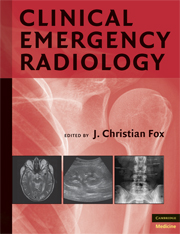Book contents
- Frontmatter
- Contents
- Contributors
- PART I PLAIN RADIOGRAPHY
- PART II ULTRASOUND
- PART III COMPUTED TOMOGRAPHY
- 28 CT in the ED: Special Considerations
- 29 CT of the Spine
- 30 CT Imaging of the Head
- 31 CT Imaging of the Face
- 32 CT of the Chest
- 33 CT of the Abdomen and Pelvis
- 34 CT Angiography of the Chest
- 35 CT Angiography of the Abdominal Vasculature
- 36 CT Angiography of the Head and Neck
- 37 CT Angiography of the Extremities
- PART IV MAGNETIC RESONANCE IMAGING
- Index
- Plate Section
32 - CT of the Chest
from PART III - COMPUTED TOMOGRAPHY
Published online by Cambridge University Press: 07 December 2009
- Frontmatter
- Contents
- Contributors
- PART I PLAIN RADIOGRAPHY
- PART II ULTRASOUND
- PART III COMPUTED TOMOGRAPHY
- 28 CT in the ED: Special Considerations
- 29 CT of the Spine
- 30 CT Imaging of the Head
- 31 CT Imaging of the Face
- 32 CT of the Chest
- 33 CT of the Abdomen and Pelvis
- 34 CT Angiography of the Chest
- 35 CT Angiography of the Abdominal Vasculature
- 36 CT Angiography of the Head and Neck
- 37 CT Angiography of the Extremities
- PART IV MAGNETIC RESONANCE IMAGING
- Index
- Plate Section
Summary
INDICATIONS
CT of the chest accounts for approximately 6% to 13% of CT scans ordered in the ED (1,2). Trauma is one of the most common indications for thoracic CT. Nevertheless, a standard protocol for the use of chest CT following blunt chest trauma remains to be established (3).
Supine chest radiography is the accepted initial imaging modality in the evaluation of chest trauma (3,4). Chest radiographs are able to diagnose or suggest many traumatic injuries, including pneumothorax, hemothorax, diaphragmatic rupture, flail chest, pulmonary contusion, pneumopericardium, and pneumo- and hemomediastinum (5). The sensitivity of chest radiography to diagnose major thoracic injuries is significantly lower than CT (6–8). It is becoming more common for emergency physicians to include a chest CT with the initial trauma imaging (5). Many studies encourage its use in major chest trauma victims (6–9) because more than 50% of major chest trauma victims with normal chest radiographs have multiple thoracic injuries on CT (9). Chest CT is extremely useful in the assessment of injuries to the aorta, chest wall, lung parenchyma, airway, pleura, and diaphragm (4).
Nontraumatic chest pain is another indication for thoracic CT. Chapter 34 discusses CT angiography in the diagnosis of pulmonary embolism and aortic dissection.
Keywords
- Type
- Chapter
- Information
- Clinical Emergency Radiology , pp. 457 - 472Publisher: Cambridge University PressPrint publication year: 2008

